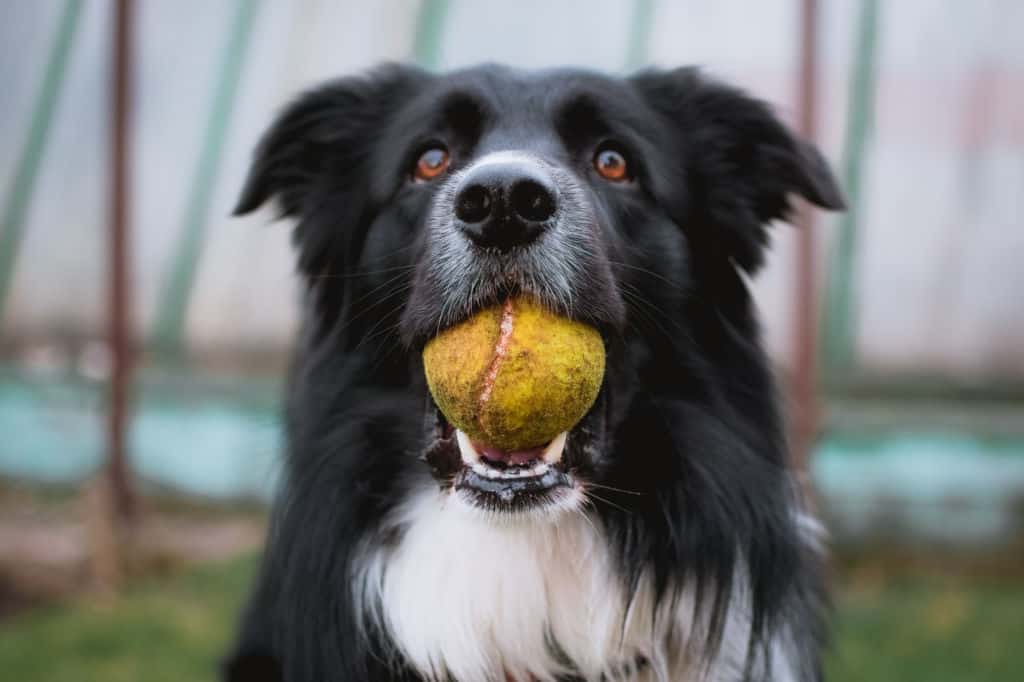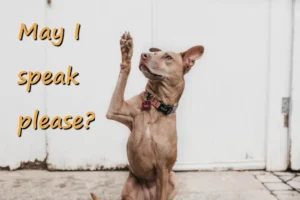Dog training can be a challenge, but it doesn’t have to be a source of frustration for you and your pet.
Positive reinforcement training is a powerful, science-backed method to help you build a deeper, more positive relationship with your dog.
In this post, we’ll share the top 10 must-know tips for using positive reinforcement to train your dog effectively and humanely, and help you achieve the results you want while strengthening the bond between you and your furry companion.

1. Clear Commands
Dogs respond well to short and simple commands, so avoiding long or confusing phrases is essential.
Teaching my dog the “stay” command was a real challenge. I tried using different phrases, such as “stay here”, or “stay put”, but nothing seemed to work. I was about to give up until I stumbled upon a clear and concise phrase that did the trick. “Wait” was the magic word!
Using this one consistent phrase made a big difference in my dog’s understanding and response. She started to respond faster and more reliably, and it became a lot easier to communicate with her.
If you’re struggling to teach your dog a new command, I encourage you to experiment with different phrases until you find the one that works best for your pup.
Using consistent language for each behavior also helps your dog learn and respond to your commands more quickly. Saying “sit” instead of “sit down” or “please sit” can make a big difference in your dog’s understanding and response with the “Sit” command.
Example: Imagine that you’re trying to teach your dog the “down” command. You say “lie down” the first time, “down boy” the second time, and “down on the ground” the third time. Your dog becomes confused and doesn’t know what you want.
Here are a few clear commands you could start with:
| What to Say | Expected Dog Response |
|---|---|
"Sit" | Dog sits down immediately |
"Stay" | Dog remains still until given a release command |
"Down" | Dog lies down with their belly and elbows touching the ground |
"Come" | Dog comes directly to you |
By using a clear and concise command, such as “down”, your dog will learn faster and be less likely to become frustrated.
2. Consistent Training
Consistency in training helps your dog learn faster and remember the behaviors you’re teaching them.
Dogs thrive on routine, so setting a regular training schedule can help them understand when it’s time to focus and learn.
For example, if you only train your dog sporadically, it may take longer for them to understand and retain the behaviors you’re teaching. But if you set a consistent training schedule, such as every day at 3 p.m., your dog will start to recognize and anticipate the training session, making it easier for them to learn and remember what you’re teaching.
I once struggled to stick to a training schedule when I was teaching my dog a new trick. I kept forgetting to practice consistently, which made it difficult for my dog to learn and progress.
However, I eventually found success by committing to practice for just a few minutes each day. This small change made a big difference in my dog’s progress and allowed us to achieve our training goals. I also learned some helpful tips for staying consistent, such as setting reminders or finding a training buddy. You can try these tips, too!
Consistent training sessions also help build trust and a stronger bond between you and your dog. When your dog knows what to expect, they will be more confident and comfortable during training, making it a positive experience for both of you.
3. Dog Body Language
Reading your dog’s body language can help you recognize when your dog is uncomfortable or stressed and adjust your training accordingly.
I learned the hard way about the importance of reading my dog’s body language. Back in the day, I had a training setback when I misinterpreted my dog’s signals and thought he was being stubborn when he refused to perform a certain behavior. Later, I realized he was actually experiencing pain in his paw, and it took a toll on both of us.
This experience taught me the importance of reading my dog’s cues and being more attentive to his body language in the future. By doing so, I was able to avoid similar issues and improve our communication and training.
Dogs use body language to communicate their feelings and intentions, and you need to be able to read these signals. For example, if your dog is licking their lips or avoiding eye contact, it may be a sign that they are feeling anxious or stressed.
Example: You are out for a walk with your dog when you come across a stranger. Your dog starts barking and growling, and you notice that their body is tense and their ears are pinned back. These are signs that your dog is feeling threatened or uncomfortable, and it’s important to remove them from the situation and work on desensitization training to help them feel more comfortable around strangers.
By learning to read and interpret your dog’s body language, you can establish a more positive and effective communication with your dog.
4. Appropriate Rewards
Rewards can be anything from treats to praise and playtime, but it’s important to choose rewards that are meaningful to your dog.
While treats are a popular choice, other rewards, such as playtime or access to a favorite toy, can be just as effective. Understanding what motivates your dog is key to choosing the most appropriate reward.
Example: You are trying to teach your dog to “come” when called. You try using treats as a reward, but your dog doesn’t seem interested. However, when you try using a favorite toy, your dog becomes more responsive and enthusiastic. This shows that using appropriate rewards can make a big difference in the success of your training.
I remember a time when I found a unique reward for my dog that made a huge difference in their behavior. I discovered that my dog loved playing tug-of-war, so I started using it as a reward for good behavior. Whenever he saw the tug toy, his tail would start wagging, and it became a fun way to bond with him while also reinforcing positive behaviors.
By using rewards that your dog enjoys, you’ll be more likely to reinforce positive behaviors and foster a stronger bond with your furry buddy.

5. Immediate Reinforcement
Dogs live in the moment and have short attention spans, so it’s important to provide reinforcement as soon as they perform a desired behavior.
This helps to reinforce the connection between the behavior and the reward, and helps your dog learn more quickly.
Example: You are trying to teach your dog to “stay” when commanded. Your dog successfully stays for a few seconds, but by the time you get the treat to give as a reward, your dog has already moved. Your dog may not understand why they are being rewarded, making training more difficult.
Reward your pup promptly and effusively with treats, praise, and playtime for a job well done. This will ensure that they understand which behaviors are desirable and make the learning process all the more fun and exciting.
6. Gradual Progression
Gradual progression is important in positive reinforcement training to prevent frustration and ensure success.
When I first got my dog, I was eager to teach her tricks, starting with the classic “shake” command. However, despite hours of trying, she just couldn’t seem to grasp the behavior. I almost gave up until I remembered the importance of breaking down the behavior into smaller steps.
Starting with small and easy behaviors and gradually increasing the difficulty helps your dog build confidence and skills. This method of training also prevents your dog from becoming overwhelmed or frustrated.
So I applied this. By rewarding her for each small step towards the behavior, like lifting her paw off the ground and then touching my hand with her paw, my dog gradually learned the full behavior of shaking hands.
Here’s another example: You are trying to teach your dog to “roll over”. Instead of trying to teach the entire behavior at once, you break it down into smaller steps. First, you teach your dog to lie down on command. Then, you teach them to roll onto their side. Finally, you teach them to roll all the way over.
This gradual progression allows your dog to build skills and confidence in each step, leading to success in the final behavior.
7. Shaping Behavior
Shaping behavior is an effective positive reinforcement technique that involves breaking down complex behaviors into small, achievable steps. By rewarding progress in small steps, you can gradually achieve the desired behavior.
To use this technique:
- Define the behavior you want to teach your dog.
- Divide the behavior into smaller steps that your dog can easily learn.
- Reward your dog for each step they successfully complete.
- Gradually increase the difficulty until they have achieved the desired behavior.
For example, let’s say you want to train your dog to lie down on command. You can start by rewarding your dog for any small movements towards the desired behavior, such as lowering their head, then lowering their chest, and finally fully lying down.
By rewarding small steps in the right direction, the dog is encouraged to continue progressing towards the desired behavior, rather than becoming frustrated or overwhelmed by attempting to learn the full behavior all at once.
This way, your dog learns complex behaviors in a way that’s easy and fun for them.
8. Avoiding Punishment
Punishing a dog for unwanted behavior can be ineffective and counterproductive in the long run.
It can lead to fear and anxiety, and damage the relationship between you and your dog.
Instead of punishment, focus on reinforcing positive behavior with rewards and positive reinforcement. If your dog is exhibiting unwanted behavior, try to understand the underlying cause and address it through positive training methods.
For example, if your dog is chewing on furniture, redirect their attention to an appropriate chew toy and reward them for using it. This can help reinforce the desired behavior and prevent future incidents of inappropriate chewing.
The cause of your dog’s chewing may be because they are bored or have excess energy. Instead of punishing them, provide appropriate chew toys and engage them in physical activity to burn off excess energy.
9. Individualized Training Approach
Every dog is unique, so it’s important to create a training plan that’s tailored to your pet’s needs and preferences. Consider factors such as age, breed, health, and past experiences when developing a personalized approach.
For example, an older dog may need a different approach to training than a young puppy. They may require more breaks during training sessions. A rescue dog with a history of abuse may require more patience and gentleness in their training, without forcing them too much.
By taking the time to understand your dog and their individual needs, you can develop a more effective training plan that is suited to their personality and learning style.
10. Patience and Perseverance
Training a dog takes time and patience, and it’s important to be consistent and persistent in your efforts.
It may take several repetitions of a command or behavior before your dog fully understands and responds, but with patience and perseverance, they will get there.
For example, if you’re trying to teach your dog to come when called, it may take several weeks of consistent training before they reliably respond. It’s important to remain patient and consistent in your training efforts, and celebrate each small success along the way.
Remember to keep a positive attitude and continue putting in the effort, as each small step forward in training builds the foundation for a strong and well-behaved pooch.
Alex, a passionate animal lover, has experience in training and understanding animal behavior. As a proud pet parent to two dogs and three cats, he founded AnimalReport.net to share insights from animal experts and expand his knowledge of the animal kingdom.









